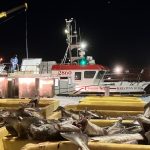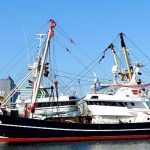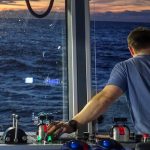Preliminary results from sea trials on an Orkney fishing vessel using a new net design developed by its skipper has shown a significant reduction in the amount of small cod caught, signalling its potential as an important tool for conserving stocks.
The trials highlight the pioneering role that Scottish fishermen are taking in developing new initiatives to aid in the conservation of fish stocks.
The results also come just ahead of crucial fish talks later this month in Brussels to decide upon quotas and other fisheries management measures for 2009, with the new net having the potential to enable Scottish fishermen to land more marketable fish, whilst at the same time allowing greater quantities of small fish to remain in the sea.
The new net idea was conceived by Orkney skipper Tam Harcus of the 33m vessel Russa Taign, who used his own knowledge and experience to design a trawl that he believed would reduce the amount of small cod caught, whilst still retaining viable catches of larger cod and valuable monkfish and megrim – something that had not been achieved before.
Tam Harcus had found that whilst he was fishing alongside other vessels his boat would catch fewer small cod. Tam put this down to his nets being made from 160mm mesh throughout the main part of the net, as opposed to the other vessels that were using 120mm mesh.
He reasoned that by increasing the mesh size to 300mm at the entrance of the trawl, he would be able to further reduce his catches of small cod whilst still retaining other marketable species.
Working in conjunction with the Scottish Government, the Conservation Credit Steering Group and the Scottish Fishermen’s Federation, the idea was put to the test in sea trials that were independently verified by a Conservation Credit observer. The trials involved fishing the new trawl design beside skipper Harcus’s normal net in a twin rig arrangement.
Preliminary results indicate that there was a sizable reduction in the amount of small cod caught with up to 61% more cod below the minimum landing size being released by the test net, compared with the normal net. The test net also released 50% more cod below 45cm length and 41% of cod below 70cm in size. Above 70cm the net only lost 6% more cod than the normal net.
The monkfish results indicated a small reduction in the monkfish catch (12%) but skipper Harcus said that this was expected as the net was new and this is a normal occurrence in such instances. Not enough megrim was caught during the trial to draw any significant conclusions on the catch rate of that species.
Tam Harcus said: “I expected there to be a reduction in the cod catch with the new net, but not to the extent that we found in these trials. These are very encouraging results and I believe that this type of trawl could play a very important role in fish stock conservation.”
For example, the new net could help meet conservation targets set under the EU’s cod recovery plan. The larger meshes in the net also offer less drag during towing, which could result in fuel cost savings.
It is planned to carry out further trials next year to assess whether the new trawl will deliver the same results on smaller vessels.
Rory Campbell, science and environment policy officer of the Scottish Fishermen’s Federation said: “While this gear will not be suitable for parts of the Scottish whitefish fleet such as those which fish mainly for roundfish such as haddock, cod and whiting, it should work quite successfully in mixed fisheries where fish such as monkfish and megrim are also being targeted. However, more work should be carried out in assessing the effectiveness of this net on smaller craft to ensure its effectiveness in this important segment of the fleet.”








